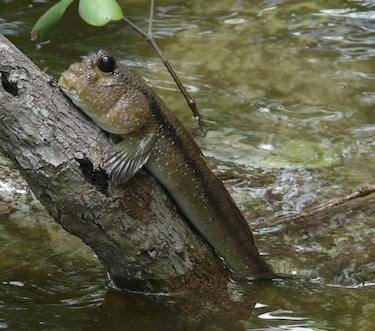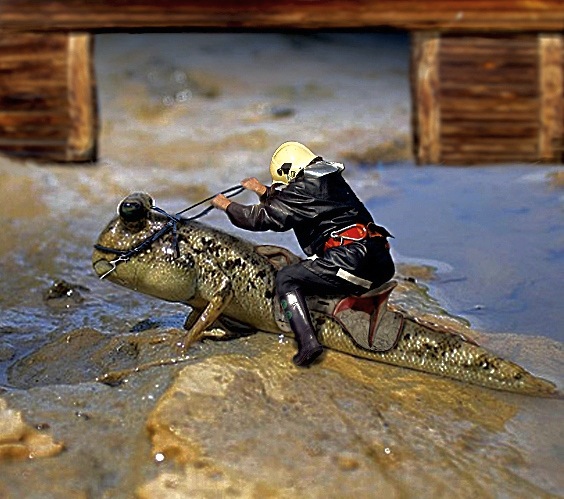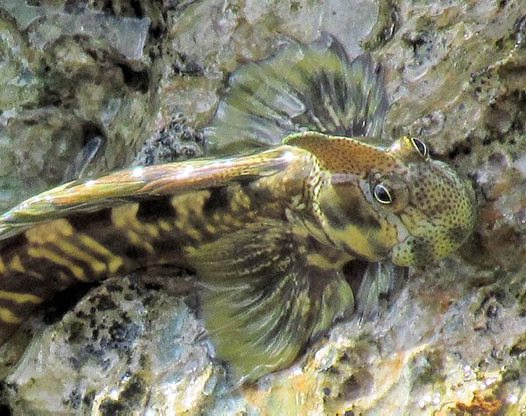“Fish gotta swim”, as Julie put it in explaining why she can’t stop lovin’ dat man in the 1927 musical Show Boat. And we all know what she meant. But do they?
Not this one.
The Pacific Leaping Blenny (yes, that is its real name) wants to do anything but swim. It literally flees from water, except to wet its whistle every now and then. This curious creature, so named because — wait for it — it leaps, is the subject of a new study by Terry Ord and Tonia Hsieh of the Uni of New South Wales in Australia. A brief introduction by the authors:
“The Pacific leaping blenny is one of the rare living examples of a fish that spends the vast majority of its time on land . . . The fish are extremely agile on land, moving quickly over complex rocky surfaces using a unique tail-twisting behavior combined with expanded pectoral and tail fin morphology that allows them to adhere to almost any firm surface. Nevertheless, life on land still comes with severe constraints for these fish. Like other marine amphibious fishes, blennies do not possess an air-breathing organ (lung), but rely on the exchange of O2 and CO2 through the skin and gills when on land. Terrestrial blennies must consequently remain moist to avoid asphyxiation. This restricts these fish to the wet intertidal rocks within the splash zone.”
Not only that but the critters have to watch their backs because “At high tide, the waves were often so violent that blennies spent most of their time clinging to rocks or sheltering in crevices and holes above the waterline.”
Check out this video of these guys scuttling around on the intertidal rocks on Guam, grazing on algae and leaping out of the way of incoming waves, and reminding me, strangely, of miniature Galapagos iguanas:
Ord and Hsieh were interested in the consequences of this bizarre lifestyle for behavior of the fishes. And this is where the love story that I promised you comes in.
But perhaps love is not the right word. Alas, the story is a familiar one. Because of the twin threats of drying up at low tide and getting pulverized by waves at high tide, the blennies have precious little time to do anything other than cower in damp rock crevices. Painstaking hours of observation by the team showed that, if I might paraphrase, females spent most of the short window of favorable conditions doing sensible things like eating algae, while males mainly loafed around and tried to get the females to have sex with them. Technically speaking, “The second display type was an exaggerated headnodding that was performed by males (see Video S1), apparently to entice females to enter a male’s rock hole to spawn.” Stop me if you’ve heard this one already. [Note: the Video S1 referred to is very cool but unfortunately only available to the journal’s subscribers]
Here’s another video, obviously shot in a public aquarium based on the lighting and background din of screeching kids, but showing some great footage of the males posturing to one another and trying to attract the ladies by raising up their colorful dorsal fins (the show starts about 30 seconds in):
Come to think of it, I’m pretty sure I’ve seen this critter. Back in the day, during one of my several postdoc stints, I spent a brief couple of months at the University of Guam’s Marine Lab feeding nasty stuff to fish on the reefs to test the effectiveness of seaweed and sponge chemical defenses (see here). The reefs in that neck o’ the woods are a different animal entirely from what I was used to in the Caribbean. As one of my dive buddies (an FBI agent, but that’s a different story) said as we came out of the water one day, “The Pacific is where it’s at.”

So one night we ventured out on foot onto the reef during a nighttime low tide — walking very gingerly since, first of all, it was night, second it was slippery as all get out, and third the reef is basically several acres of sharp, occasionally poisonous rock. Oh and there are waves. And I think I mentioned it’s dark.
Anyway, we started poking around in holes and crevices with our flashlights (or torches for non-American Anglophones) and I was completely perplexed at finding these little fishes just everywhere — hanging out on top of the rocks. Might well have been leaping blennies but I seem to recall some little pinkish eels too.
And then Guam also has the famous mudskipper, which is basically a larger version of the leaping blenny (only it’s a goby) that hangs out on exposed mud in the mangrove swamps. And occasionally climbs trees. Verily, truth is stranger than fiction.

What is it about this place that has driven so many different types of fish out of the water? Perhaps surprisingly, the authors of the new study don’t address that question. It’s admittedly a tough one to answer since it involves a long history of evolution, mostly under conditions that are now unknown to us. The original landscape of Guam was basically torched by incoming American forces at the end of the 2nd World War, and if that wasn’t enough its terrestrial environment has been completely transformed by exotic species, notably the infamous brown tree snake, that ate more or less every endemic bird on the island to extinction and has grown so abundant that (so I’ve heard) piles of snakes chilling on telephone wires occasionally become so heavy that they snap the wires and cause power outages. The point is that the current environment is not a very reliable clue to the past.
Still, we can speculate. It’s certainly well documented that coral reefs are chock-a-block with predators of all types, or at least were before we ate most of them, so threats to a small fish in the water were probably intense during most of their evolutionary history. Conversely, oceanic islands like Guam commonly have relatively few terrestrial vertebrates, so perhaps the blennies and other landlubber fishes could breathe a little easier (if you’ll pardon the pun) on the dry side. Just a thought. One of nature’s many mysteries.


Leave a Reply